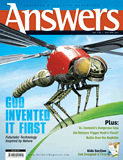The Technology of Flight
Originally published in Creation 3, no 4 (November 1980): 10-12.
Many of our textbooks suggest that it is man’s superior intelligence which has enabled our species to modify the environment by technological innovations and so give us some control of our evolution. Increasing technological advance is seen as our salvation in the struggle to survive.
However, these texts do not suggest that our technology was achieved by accident. It is accepted as the result of applied intelligence building on the achievement of earlier generations. Animal behavior is the result of inbuilt responses to external stimuli, allied with a limited ability to learn from experience. While some animals make limited use of tools, none approaches man’s ability to design and innovate. Yet when we look at the way in which animals are suited to their environment, we find that many animals have inbuilt devices which far surpass the technological achievements of which man is so proud.
Take flight, for instance. Thoresen (1971) claims that if a small airplane were as efficient as the plover, it would fly 56 km on one liter of gasoline. Birds show excellent aerodynamic design.
Their flight apparatus includes:
- intricately constructed feathers, very strong for their weight (Feathers streamline the body, protect against heat and cold, and fan the air.)
- powerful wings, controlled by strong muscles
- light hollow bones, flexible but strong
- a rigid skeletal framework
- a circulatory system incorporating a large, strong heart, high blood pressure, and the extra pigment myoglobin to facilitate respiration
- a remarkable respiratory system, including air sacs which permeate the bones—(This produces buoyancy and a greater respiratory and surface cooling area.)
- a digestive system which, coupled with high body temperature, and efficient circulation, produces a high blood sugar concentration—(Birds can utilize a very great percentage of energy from food.)
- concentrated urine to reduce water loss and weight
- uncanny navigation
- keen nervous coordination which correlates the position of each feather in flight.
No one of these features enables flight. It is only when they are put together that birds fly. Each feature could not evolve separately to its current perfection and then unite harmoniously with the other.
Flying patterns in the animal kingdom include power flying, gliding, soaring and flight like the helicopter of humming birds and dragonflies. Each has special variations for its specific mode of flight.
It is of interest to note that our planes, helicopters and gliders, designed with purpose, cannot match the design standards observed in animals following innate behavior patterns.
It is obvious that the animals did not design these devices, so how shall we explain them? Can accident produce greater design precision than intelligence? Such structures declare a Creator who knew what He was doing and planned accordingly.
Recommended Resources

Answers in Genesis is an apologetics ministry, dedicated to helping Christians defend their faith and proclaim the good news of Jesus Christ.
- Customer Service 800.778.3390
- © 2024 Answers in Genesis



